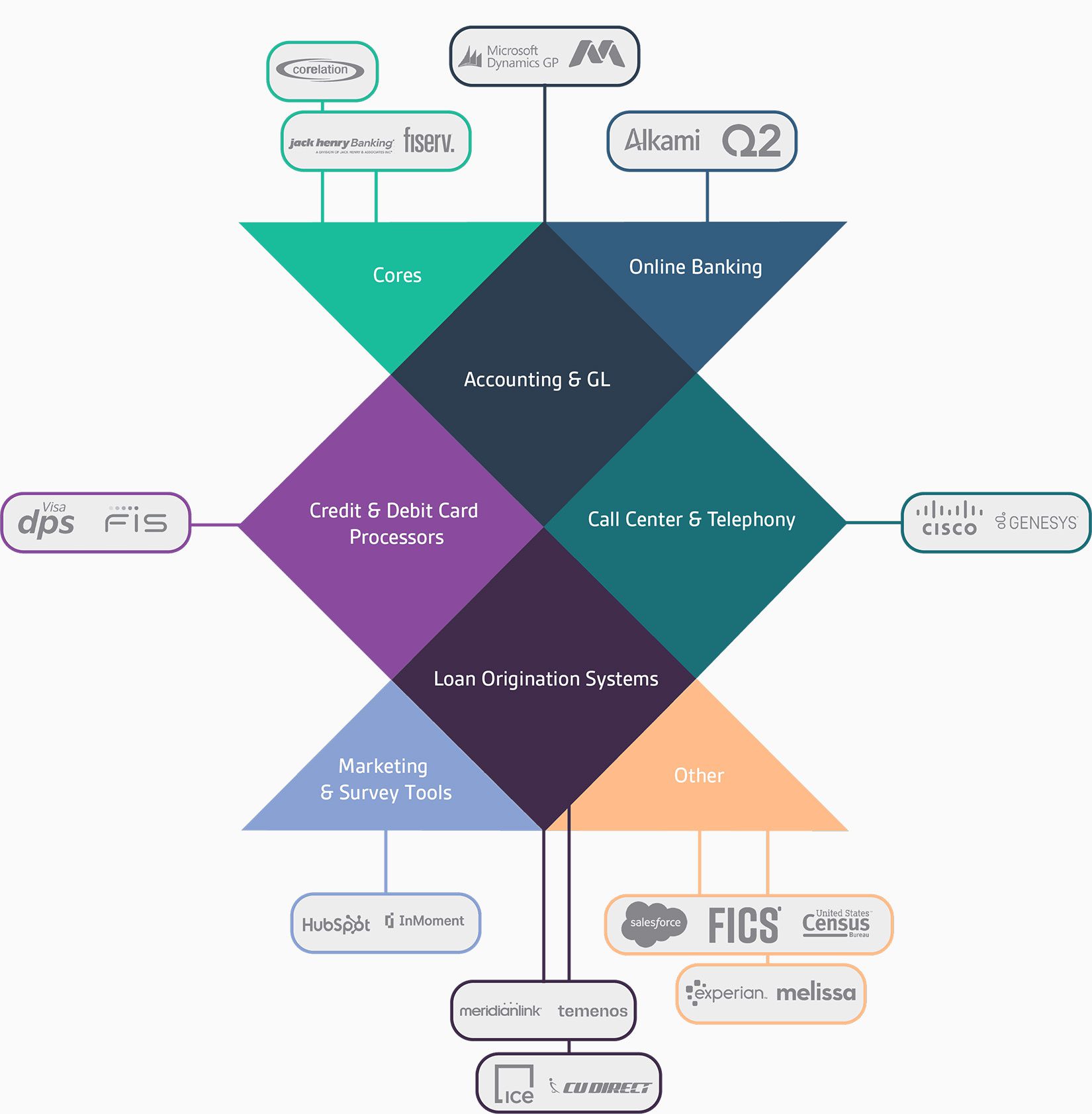Why Does Good Data Management Matter to Your Members?
When running a financial institution you know that data is an important part of your operations. You’re regularly collecting customer (for our bank readers) and member (for our credit union ...
Your data analytics program doesn’t have to be stressful. From data governance to segmentation, we can help you achieve measurable outcomes.

Stand out from the competition and stay ahead of the curve with the latest and greatest in AI technology.
Pre-built integrations with 50+ of the leading credit union solutions, like consumer loan and mortgage originations, digital banking, CRM / MRM, third-party data vendors, and more.
Dozens of dashboards encompassing 250+ visualizations in a robust, pre-built PowerBI Reporting Suite.
A data quality and governance suite that conforms to you, not the other way around.
Limitless ad hoc insight generation to answer all questions about your financial institution’s data.
Full suite of financial analytics features encompassing GL and accounting, profitability, and regulatory reporting.
AI-driven engagement model that aggregates and segments customers to enhance retention and increase customer lifetime value.
Cut out the expense and time trying to build it on your own and get your analytics platform implemented in weeks not years.
A full suite of dashboards, reports and analytics features covering risk mitigation to branch reporting to incentive calculations
Stand out from the competition and stay ahead of the curve with the latest and greatest in AI technology.
Pre-built integrations with 50+ of the leading credit union solutions, like consumer loan and mortgage originations, digital banking, CRM / MRM, third-party data vendors, and more.
Dozens of dashboards encompassing 250+ visualizations in a robust, pre-built PowerBI Reporting Suite.
A data quality and governance suite that conforms to you, not the other way around.
Limitless ad hoc insight generation to answer all questions about your financial institution's data.
Full suite of financial analytics features encompassing GL and accounting, profitability, and regulatory reporting.
AI-driven engagement model that aggregates and segments customers to enhance retention and increase customer lifetime value.
Cut out the expense and time trying to build it on your own and get your analytics platform implemented in weeks not years.
A full suite of dashboards, reports and analytics features covering risk mitigation to branch reporting to incentive calculations
Here at Gemineye, we use breakthrough architecture to create the most flexible data analytics solution available.

When running a financial institution you know that data is an important part of your operations. You’re regularly collecting customer (for our bank readers) and member (for our credit union ...
Why Data Analytics Matters Data analytics is essential for staying competitive in today’s competitive landscape. A recent study by Jack Henry found that 42% of credit unions prioritize leveraging data ...
Welcome to our very first edition of “A Day in the Life of a Data Analyst,” featuring the equally talented and down-to-earth Ann Ditlow, Data Analyst at 4Front CU. Ann ...


The Data Lakehouse Platform for Dummies Brought to you by our partner Databricks Looking to streamline your bank or credit union’s data management strategy? The Data Lakehouse Platform for Dummies, Databricks Special Edition, explores how a modern data lakehouse architecture combines the best features of data lakes and data warehouses to simplify analytics at scale. In this free whitepaper, you’ll learn: How the data lakehouse evolved from traditional data management (DM) solutions Why outdated architectures limit speed, flexibility, and insight generation How a cloud-native data lakehouse solves today’s data challenges What it takes to design and build a scalable cloud data platform for your financial organization Whether you’re a data leader, architect, or business decision-maker, this whitepaper offers practical insights on transforming your data infrastructure with the power of Databricks and the lakehouse model.
If you’re in operations at a credit union or community bank, your data is one of your most valuable assets. It helps you understand member behavior, identify product opportunities, and personalize services that drive retention. But as data pours in from every direction, transaction histories, call center logs, product usage reports, many institutions find themselves overwhelmed. Too much data, stored in too many places, often leads to fragmented reporting, missed insights, and delayed decision-making. The solution? A data infrastructure that can scale with your needs, unify your information, and deliver real-time business intelligence. That’s where the data lakehouse comes in. What Is a Data Warehouse? A data warehouse is a centralized repository designed for storing structured data – typically the kind you’d find in spreadsheets, reports, and transactional databases. It enables organized querying, analysis, and business intelligence. However, building and maintaining a data warehouse isn’t always simple. It requires a skilled data team, ongoing maintenance, and significant investment. If your organization doesn’t have a dedicated data engineering department, the warehouse approach alone can be costly and difficult to scale. What Is a Data Lake? A data lake is designed to store massive volumes of raw data in its native format. That means everything from .csv files to call recordings, videos, and images can be stored together in one location. Data lakes are flexible and ideal for organizations experimenting with machine learning or AI-powered tools. The downside? Data lakes don’t inherently organize or structure that information for everyday use. Without strong governance or specialized tools, it becomes difficult for business users to access and interpret the data, slowing down reporting and analytics. What Is a Data Lakehouse? A data lakehouse combines the flexibility of a data lake with the structured querying power of a data warehouse. It supports both raw and structured data, making it easier to feed your business intelligence (BI) tools and extract valuable insights. For credit unions and community banks, this hybrid model is ideal. It allows you to store everything, structured member data, unstructured interaction logs, and everything in between, while also giving analysts and business teams access to organized, actionable information in real time. Key Benefits of a Data Lakehouse for Financial Institutions Unified data architecture: Avoid silos by consolidating all types of data into one central platform. Real-time analytics: Enable fast reporting and dashboarding without duplicating data sets. Scalability: Grow your data infrastructure as your organization evolves. Cost efficiency: Reduce overhead by eliminating the need for separate tools and duplicate storage systems. AI and machine learning ready: Leverage future-ready capabilities as your institution innovates. Why the Gemineye Data Lakehouse Stands Out Gemineye has developed a data lakehouse platform specifically for credit unions and community banks. Built on Microsoft and Databricks technologies, the Gemineye Data Lakehouse merges raw data flexibility with enterprise-grade analytics, making it easier to transform data into decisions. What makes us different: Tailored for your industry: Every feature supports the specific workflows and reporting needs of financial institutions. Intuitive interface: Both technical teams and business users can easily navigate, analyze, and act on their data. No vendor bloat: We’re focused, agile, and purpose-built for organizations like yours. See Gemineye’s Data Lakehouse in Action Want to simplify your data infrastructure and get more value from your BI tools? Gemineye’s Data Lakehouse is designed to do exactly that. Schedule a personalized demo to see how our platform can transform how your institution stores, manages, and uses data—without the hard sell.
A Guide to Using Data to Overcome Operational Challenges Have you ever suggested a solution to a strategic problem at a meeting, only to be shot down by individuals concerned with their own departmental priorities? Lack of operational alignment is a challenge that disrupts financial institutions in many capacities. Nebulous data sets, incongruent results across departments, and a lack of consistent reporting creates a scenario where leaders are left scratching their heads over often straight-forward goals. What You’ll Learn from This Whitepaper We discuss key activities to utilize data as part of your next strategic planning session, goal setting process, or throughout the year to strengthen operations at your credit union or bank. Topics include: Creating a unified scoreboard Translating goals from strategic to tactical Finding your alignment champion Why This Guide Matters for Credit Unions and Community Banks Whether you are a technical leader, like a VP of Data or IT, or a non-technical leader, like a CMO or CLO, this paper will be a helpful tool for exploring how to use data to consistently create operational alignment for your credit union or community bank. Download this guide filled with examples and tips for improvement today!